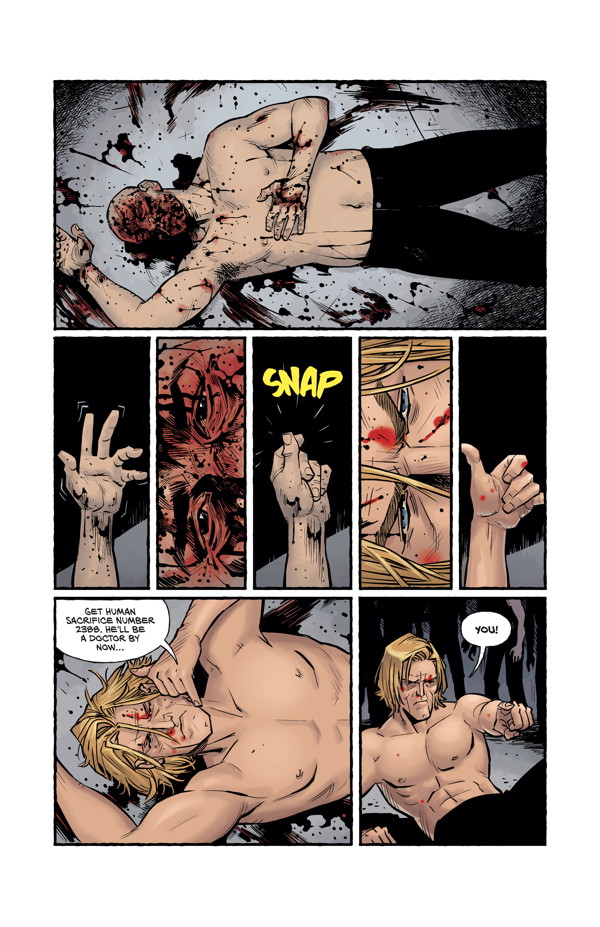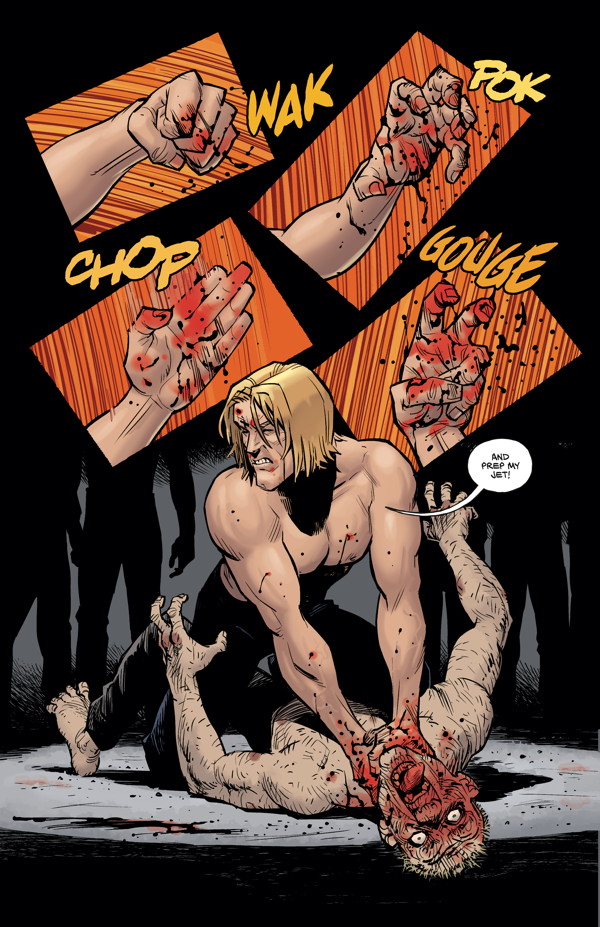Fight Club 2 #5 Review
"Rage Against the Something or Other"
The comic book sequel of the novel
Fight Club has been bizarre in a number of ways, including writer Chuck Palahniuk showing up in a random meta moment and more fight clubbing. Things go off the rails, however, in
Fight Club 2 #5, an issue that has Tyler Durden have his soldiers commit suicide-art vandalism because of… reasons? It’s hard now to understand the point of the series as anything other than nostalgia.

The Tyler Durden that has emerged in
Fight Club 2 #5 (and earlier issues) does not have any of the charisma that the original version had. Instead, he’s like a power-mad bro who thinks he is a radical. Rather than working against financial institutions or some other radical social justice cause though, Durden now seems to be supporting spreading disease, militias and other sorts of nefarious aims that do not seem to have any noble undercurrents.
In
Fight Club 2 #5, the majority of the plot involves a small group from the “Rize or Die” collective going to a museum where they are going to kill themselves by slicing their arms in order to vandalize a group of important artworks (that conveniently are all grouped in the same hallway). How does this help Rize or Die’s aims? Also, what exactly are Rize or Die’s aims? It doesn’t seem to really matter as
Fight Club 2 is doubling-down on the narrative obfuscation tricks of an unreliable narrator – things that seemed (mostly) clever in the original but are now generally just annoying.

The logistics of the transformation from mild-mannered Sebastian to super-id Tyler are also hard to rectify. The comic shows him as a buff, attractive blonde when he is Tyler, but the reality is that he looks the same (not buff, attractive or blonde) at all times to others. There is something farcical about this one guy play-acting as another, and there is even a moment in
Fight Club 2 #5 when one Rize or Die member asks “Who’s He Now?” that it seems like Palahniuk is making fun of the whole premise, but that quickly evaporates when Tyler starts making orders.
Ultimately, the idea of a lost, middle-aged guy acting like his peak wish-fulfillment self is sad, especially since in this case it involves a good degree of mental illness. However, Palahniuk doesn’t seem really interested in presenting a realistic or compassionate portrayal of someone with a split personality but rather a bad-ass dude who gets shit done and earns respect. It’s true that this was the case in the original
Fight Club but the original concept concealed some of the weirdness of the situation, which is now quite clear.

On the art side, Cameron Stewart’s illustrations are mostly pretty solid. His style is very comic book-like, and it does rather undercut dramatic situations, though that seems intentional. However, an art device that was briefly used in the first issue returns here, with much lessened effect. The art is obscured in places by meta, “three-dimensional” pills drawn over the panels, hiding the faces of the Rize or Die vandalizers. It was a novel approach when used earlier in the series, but here it just feels too familiar and uninteresting, hiding things not out of purpose but out of a lack of purpose.
Sebastian/Tyler is supposed one of the Rize or Die members who opens his veins to vandalize art, though there is little doubt that he will return in the next issue just as he returned relatively unscathed after a savage beating at the end of
Fight Club 2 #4. There are a lot of things happening in this series, and there have been a few issues with moments of promise, but overall it’s hard to figure out why readers should care, unless they are hardcore Tyler Durden fans.
Fight Club 2 #5 goes in a pointless direction that doesn’t pay off and indicates that there may not be much of an overarching vision to this sequel.
Pros
- Cameron Stewart's illustrations are solid
Cons
- The plot seems pointless and the series doesn't seem to be going anywhere
- Tyler Durden is a villain and it's hard to see why he's interesting here
- Stewart's use of drawn objects over the panel worked better in the first issue
 The Tyler Durden that has emerged in Fight Club 2 #5 (and earlier issues) does not have any of the charisma that the original version had. Instead, he’s like a power-mad bro who thinks he is a radical. Rather than working against financial institutions or some other radical social justice cause though, Durden now seems to be supporting spreading disease, militias and other sorts of nefarious aims that do not seem to have any noble undercurrents.
In Fight Club 2 #5, the majority of the plot involves a small group from the “Rize or Die” collective going to a museum where they are going to kill themselves by slicing their arms in order to vandalize a group of important artworks (that conveniently are all grouped in the same hallway). How does this help Rize or Die’s aims? Also, what exactly are Rize or Die’s aims? It doesn’t seem to really matter as Fight Club 2 is doubling-down on the narrative obfuscation tricks of an unreliable narrator – things that seemed (mostly) clever in the original but are now generally just annoying.
The Tyler Durden that has emerged in Fight Club 2 #5 (and earlier issues) does not have any of the charisma that the original version had. Instead, he’s like a power-mad bro who thinks he is a radical. Rather than working against financial institutions or some other radical social justice cause though, Durden now seems to be supporting spreading disease, militias and other sorts of nefarious aims that do not seem to have any noble undercurrents.
In Fight Club 2 #5, the majority of the plot involves a small group from the “Rize or Die” collective going to a museum where they are going to kill themselves by slicing their arms in order to vandalize a group of important artworks (that conveniently are all grouped in the same hallway). How does this help Rize or Die’s aims? Also, what exactly are Rize or Die’s aims? It doesn’t seem to really matter as Fight Club 2 is doubling-down on the narrative obfuscation tricks of an unreliable narrator – things that seemed (mostly) clever in the original but are now generally just annoying.
 The logistics of the transformation from mild-mannered Sebastian to super-id Tyler are also hard to rectify. The comic shows him as a buff, attractive blonde when he is Tyler, but the reality is that he looks the same (not buff, attractive or blonde) at all times to others. There is something farcical about this one guy play-acting as another, and there is even a moment in Fight Club 2 #5 when one Rize or Die member asks “Who’s He Now?” that it seems like Palahniuk is making fun of the whole premise, but that quickly evaporates when Tyler starts making orders.
Ultimately, the idea of a lost, middle-aged guy acting like his peak wish-fulfillment self is sad, especially since in this case it involves a good degree of mental illness. However, Palahniuk doesn’t seem really interested in presenting a realistic or compassionate portrayal of someone with a split personality but rather a bad-ass dude who gets shit done and earns respect. It’s true that this was the case in the original Fight Club but the original concept concealed some of the weirdness of the situation, which is now quite clear.
The logistics of the transformation from mild-mannered Sebastian to super-id Tyler are also hard to rectify. The comic shows him as a buff, attractive blonde when he is Tyler, but the reality is that he looks the same (not buff, attractive or blonde) at all times to others. There is something farcical about this one guy play-acting as another, and there is even a moment in Fight Club 2 #5 when one Rize or Die member asks “Who’s He Now?” that it seems like Palahniuk is making fun of the whole premise, but that quickly evaporates when Tyler starts making orders.
Ultimately, the idea of a lost, middle-aged guy acting like his peak wish-fulfillment self is sad, especially since in this case it involves a good degree of mental illness. However, Palahniuk doesn’t seem really interested in presenting a realistic or compassionate portrayal of someone with a split personality but rather a bad-ass dude who gets shit done and earns respect. It’s true that this was the case in the original Fight Club but the original concept concealed some of the weirdness of the situation, which is now quite clear.
 On the art side, Cameron Stewart’s illustrations are mostly pretty solid. His style is very comic book-like, and it does rather undercut dramatic situations, though that seems intentional. However, an art device that was briefly used in the first issue returns here, with much lessened effect. The art is obscured in places by meta, “three-dimensional” pills drawn over the panels, hiding the faces of the Rize or Die vandalizers. It was a novel approach when used earlier in the series, but here it just feels too familiar and uninteresting, hiding things not out of purpose but out of a lack of purpose.
Sebastian/Tyler is supposed one of the Rize or Die members who opens his veins to vandalize art, though there is little doubt that he will return in the next issue just as he returned relatively unscathed after a savage beating at the end of Fight Club 2 #4. There are a lot of things happening in this series, and there have been a few issues with moments of promise, but overall it’s hard to figure out why readers should care, unless they are hardcore Tyler Durden fans. Fight Club 2 #5 goes in a pointless direction that doesn’t pay off and indicates that there may not be much of an overarching vision to this sequel.
On the art side, Cameron Stewart’s illustrations are mostly pretty solid. His style is very comic book-like, and it does rather undercut dramatic situations, though that seems intentional. However, an art device that was briefly used in the first issue returns here, with much lessened effect. The art is obscured in places by meta, “three-dimensional” pills drawn over the panels, hiding the faces of the Rize or Die vandalizers. It was a novel approach when used earlier in the series, but here it just feels too familiar and uninteresting, hiding things not out of purpose but out of a lack of purpose.
Sebastian/Tyler is supposed one of the Rize or Die members who opens his veins to vandalize art, though there is little doubt that he will return in the next issue just as he returned relatively unscathed after a savage beating at the end of Fight Club 2 #4. There are a lot of things happening in this series, and there have been a few issues with moments of promise, but overall it’s hard to figure out why readers should care, unless they are hardcore Tyler Durden fans. Fight Club 2 #5 goes in a pointless direction that doesn’t pay off and indicates that there may not be much of an overarching vision to this sequel.